Intro
Discover Mutually Exclusive Collectively Exhaustive (MECE) principles, ensuring event sets are both exclusive and exhaustive, with related concepts like partitioning, categorization, and set theory, for precise data analysis and decision-making.
The concept of mutually exclusive and collectively exhaustive (MECE) is a fundamental principle in various fields, including mathematics, statistics, and decision-making. It is essential to understand this concept to make informed decisions and analyze data effectively. In this article, we will delve into the definition, importance, and applications of MECE, providing examples and explanations to help readers grasp this concept.
Mutually exclusive events or categories are those that cannot occur simultaneously. In other words, if one event happens, the other cannot happen at the same time. For instance, a coin can either land on heads or tails, but it cannot land on both at the same time. This concept is crucial in probability theory, as it helps calculate the probability of events occurring.
On the other hand, collectively exhaustive events or categories are those that cover all possible outcomes. In other words, every possible outcome is included in the categories, leaving no gap or overlap. Using the coin example again, the categories "heads" and "tails" are collectively exhaustive, as they cover all possible outcomes of a coin toss.
Understanding Mutually Exclusive and Collectively Exhaustive

The combination of mutually exclusive and collectively exhaustive categories is essential in many applications. It ensures that every possible outcome is accounted for, and there is no overlap or gap between categories. This principle is widely used in decision-making, data analysis, and problem-solving.
For example, in market research, MECE categories can help analyze customer preferences. Suppose a company wants to understand how customers prefer to shop: online, in-store, or through a mobile app. These categories are mutually exclusive, as a customer can only shop through one channel at a time. They are also collectively exhaustive, as they cover all possible shopping channels.
Importance of MECE in Decision-Making
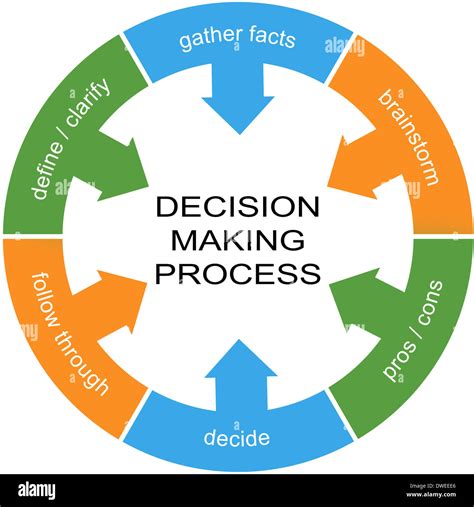
The MECE principle is vital in decision-making, as it helps ensure that all possible options are considered, and there is no overlap or duplication. By using MECE categories, decision-makers can:
- Identify all possible solutions to a problem
- Evaluate each option objectively
- Avoid duplication or overlap between options
- Make informed decisions based on a comprehensive analysis
In business, MECE is used in strategic planning, risk management, and performance evaluation. It helps companies identify key drivers of success, mitigate risks, and measure performance effectively.
Applications of MECE in Statistics and Data Analysis
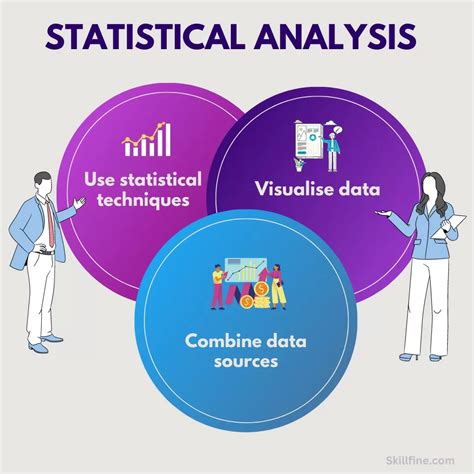
MECE is a fundamental principle in statistics and data analysis. It is used to:
- Define categories for data collection and analysis
- Ensure that data is accurately classified and coded
- Analyze data using statistical methods, such as hypothesis testing and confidence intervals
- Interpret results and draw meaningful conclusions
In data analysis, MECE categories help ensure that data is accurately categorized and analyzed. For example, in a survey, respondents may be asked to select their age group from a set of MECE categories: 18-24, 25-34, 35-44, 45-54, and 55 or older. These categories are mutually exclusive, as a respondent can only belong to one age group. They are also collectively exhaustive, as they cover all possible age groups.
Steps to Create MECE Categories

Creating MECE categories involves several steps:
- Define the purpose and scope of the categories
- Identify all possible outcomes or options
- Group similar outcomes or options into categories
- Ensure that categories are mutually exclusive and collectively exhaustive
- Test and refine the categories as needed
By following these steps, you can create effective MECE categories that help you make informed decisions, analyze data accurately, and solve problems efficiently.
Common Mistakes to Avoid

When creating MECE categories, it is essential to avoid common mistakes, such as:
- Overlapping categories: Categories that overlap or duplicate each other can lead to confusion and inaccurate analysis.
- Gaps between categories: Categories that do not cover all possible outcomes can lead to missed opportunities or incorrect conclusions.
- Unclear or ambiguous categories: Categories that are unclear or ambiguous can lead to misclassification or misinterpretation of data.
By avoiding these mistakes, you can create effective MECE categories that help you achieve your goals and make informed decisions.
Real-World Examples of MECE

MECE is used in various real-world applications, such as:
- Market research: MECE categories help analyze customer preferences and behaviors.
- Risk management: MECE categories help identify and mitigate risks in business and finance.
- Medical diagnosis: MECE categories help diagnose diseases and develop treatment plans.
- Quality control: MECE categories help evaluate product quality and identify areas for improvement.
These examples demonstrate the importance and versatility of MECE in various fields.
Gallery of MECE Examples
MECE Image Gallery
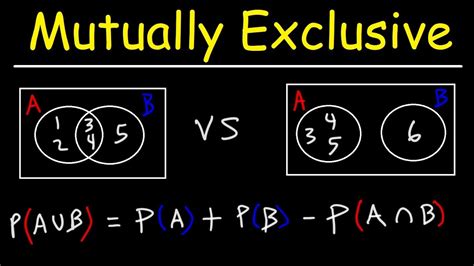
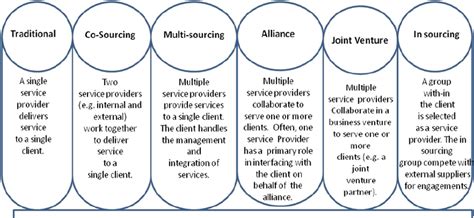

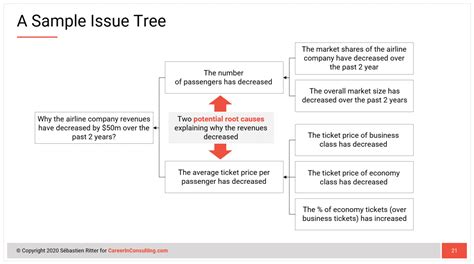
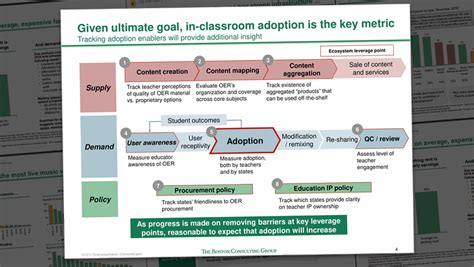
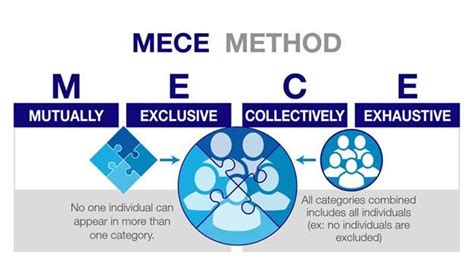
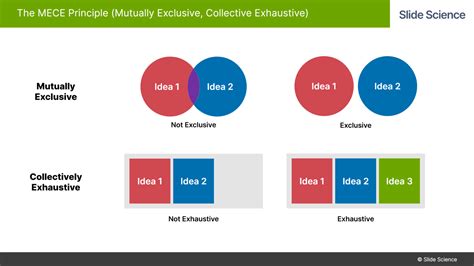
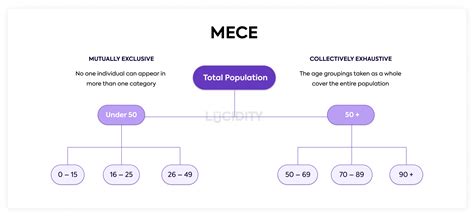
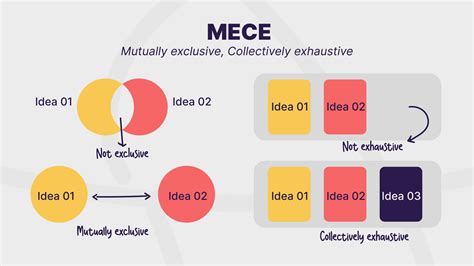
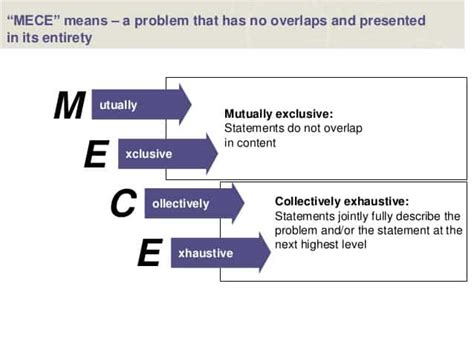
What is the purpose of MECE categories?
+The purpose of MECE categories is to ensure that all possible outcomes or options are accounted for, and there is no overlap or gap between categories.
How do I create MECE categories?
+To create MECE categories, define the purpose and scope of the categories, identify all possible outcomes or options, group similar outcomes or options into categories, ensure that categories are mutually exclusive and collectively exhaustive, and test and refine the categories as needed.
What are the benefits of using MECE categories?
+The benefits of using MECE categories include ensuring that all possible outcomes or options are accounted for, avoiding overlap or duplication between categories, and making informed decisions based on a comprehensive analysis.
Can MECE categories be used in real-world applications?
+Yes, MECE categories can be used in various real-world applications, such as market research, risk management, medical diagnosis, quality control, and decision-making.
How do I avoid common mistakes when creating MECE categories?
+To avoid common mistakes when creating MECE categories, ensure that categories are mutually exclusive and collectively exhaustive, avoid overlapping categories, and test and refine the categories as needed.
In summary, the concept of mutually exclusive and collectively exhaustive (MECE) is a fundamental principle in various fields, including mathematics, statistics, and decision-making. By understanding and applying MECE categories, you can make informed decisions, analyze data accurately, and solve problems efficiently. Remember to create MECE categories by defining the purpose and scope, identifying all possible outcomes or options, grouping similar outcomes or options into categories, ensuring that categories are mutually exclusive and collectively exhaustive, and testing and refining the categories as needed. Avoid common mistakes, such as overlapping categories, gaps between categories, and unclear or ambiguous categories. With practice and experience, you can become proficient in creating and applying MECE categories to achieve your goals and make informed decisions. We encourage you to share your thoughts and experiences with MECE categories in the comments section below.
